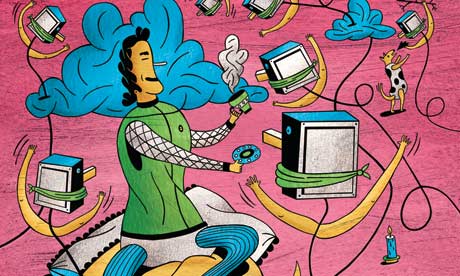
As you're doubtless aware, 2012 is the year the world will end, according to one interpretation of Mayan astrology – a preposterous belief for which there is zero evidence, other than, you know, almost everything that's happening to the economy and the environment. Oh, and also this sign of impending apocalypse, from a study I recently encountered: apparently, multitasking is making us worse at multitasking. No, you didn't misread that because you were simultaneously checking Facebook while helping your daughter with her homework. It's well known that multitasking is unproductive, but a team of American researchers studying "chronic media multitasking" found that people seem to grow less effective at frequent task-switching with practice. The alarming suggestion is that the kind of activities encouraged by new technologies might actually make us worse at navigating precisely the kind of distraction-filled world those technologies are ushering in. Depressed by that thought? Don't worry, an iPhone game featuring an adorable baby polar bear will be along to take your mind off it shortly.
One standard reaction to this is that we should embrace techno-distraction; another is that we should shun it, unplugging frequently in favour of silent contemplation or frolicking across mountaintops. But a movement headed by academics at Stanford University suggests a tantalising third option: what if we could harness the technology itself to induce serenity? "We're working on designing interactive systems that create states of calm in their users," says Neema Moraveji, who runs what must be Stanford's most chilled-out research operation: the Calming Technology Laboratory.
Calm tech is already here, in the shape of numerous programs that promise to combat electronic distraction: examples include Freedom, which temporarily cuts internet access; Anti-Social, which locks down Facebook and Twitter; StayFocusd, an extension for the Chrome browser; and my current favourite, Shroud, which inserts a solid colour backdrop immediately behind your current Mac window. My Kindle is calm tech, too: it claims to do only a few things, and it's rubbish at all of them except letting me read. That's how it should be.
But Moraveji wants to go further, to the physiology of calm. Observing people at work on computers, the technology consultant Linda Stone notes many of us unconsciously hold our breath, or breathe shallowly, especially while responding to email – a habit that compounds stress. Morveji's BreathAware project uses wearable sensors to inform people when they're breathing well. (Users can accumulate "calm points" for stretches of good behaviour.)
There could be pitfalls here. We wouldn't want to become as dependent on technology for our calmness as some already are for stimulation. But the best calm tech, Moraveji argues, will work less like Valium and more like mindfulness meditation, strengthening our self-awareness so we retain the capacity to choose, say, when to go online and when to disconnect. After all, that's surely the nub of the techno-distraction problem: the feeling that you can't resist clicking, that you're no longer in command. Perhaps it's time to leave the luddites and the futurists to squabble among themselves, and to focus instead on making sure that technology does what we want, not what it wants. Otherwise, you can't really call yourself a computer user – it's your computer that's a human user.
oliver.burkeman@theguardian.com; twitter.com/oliverburkeman

